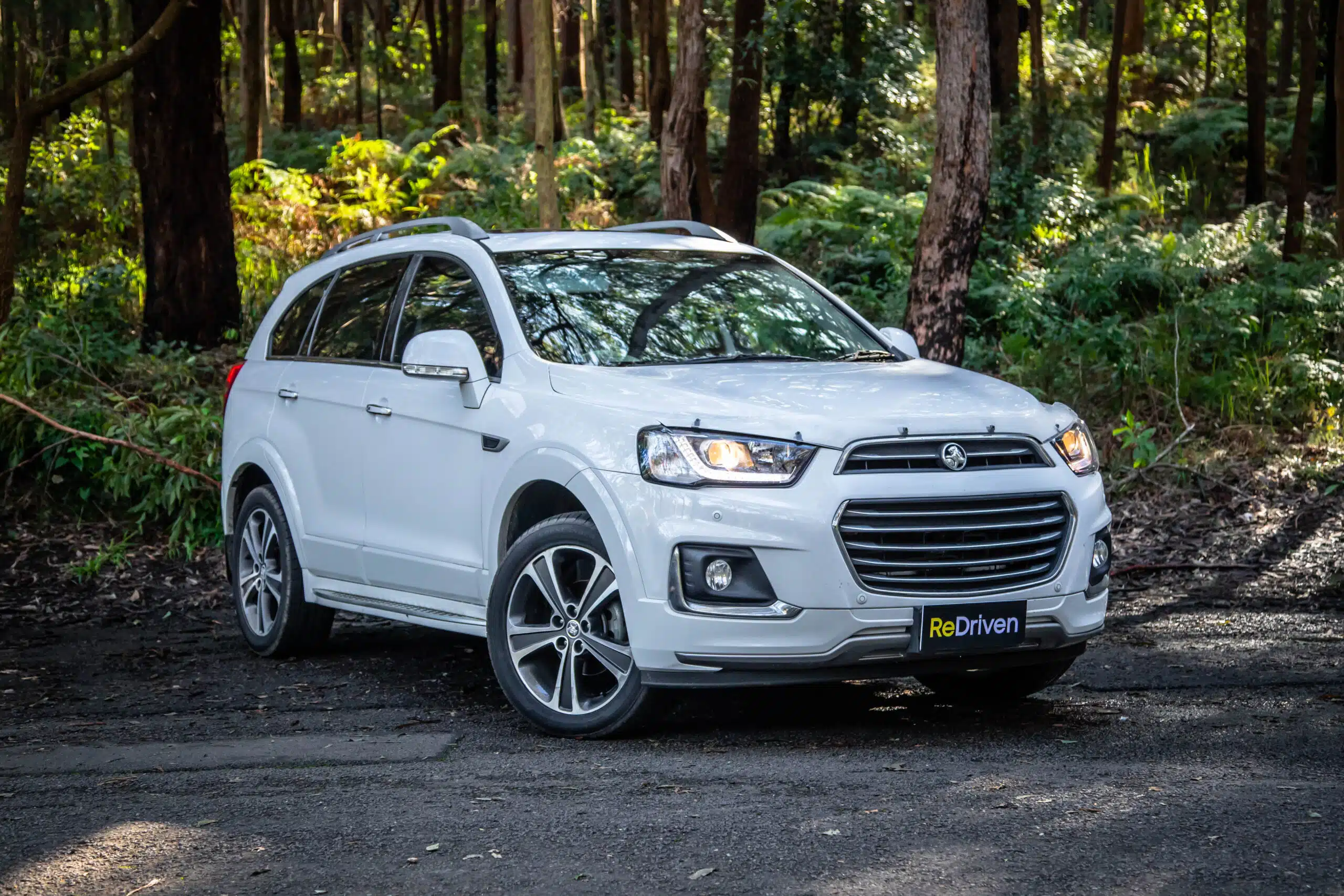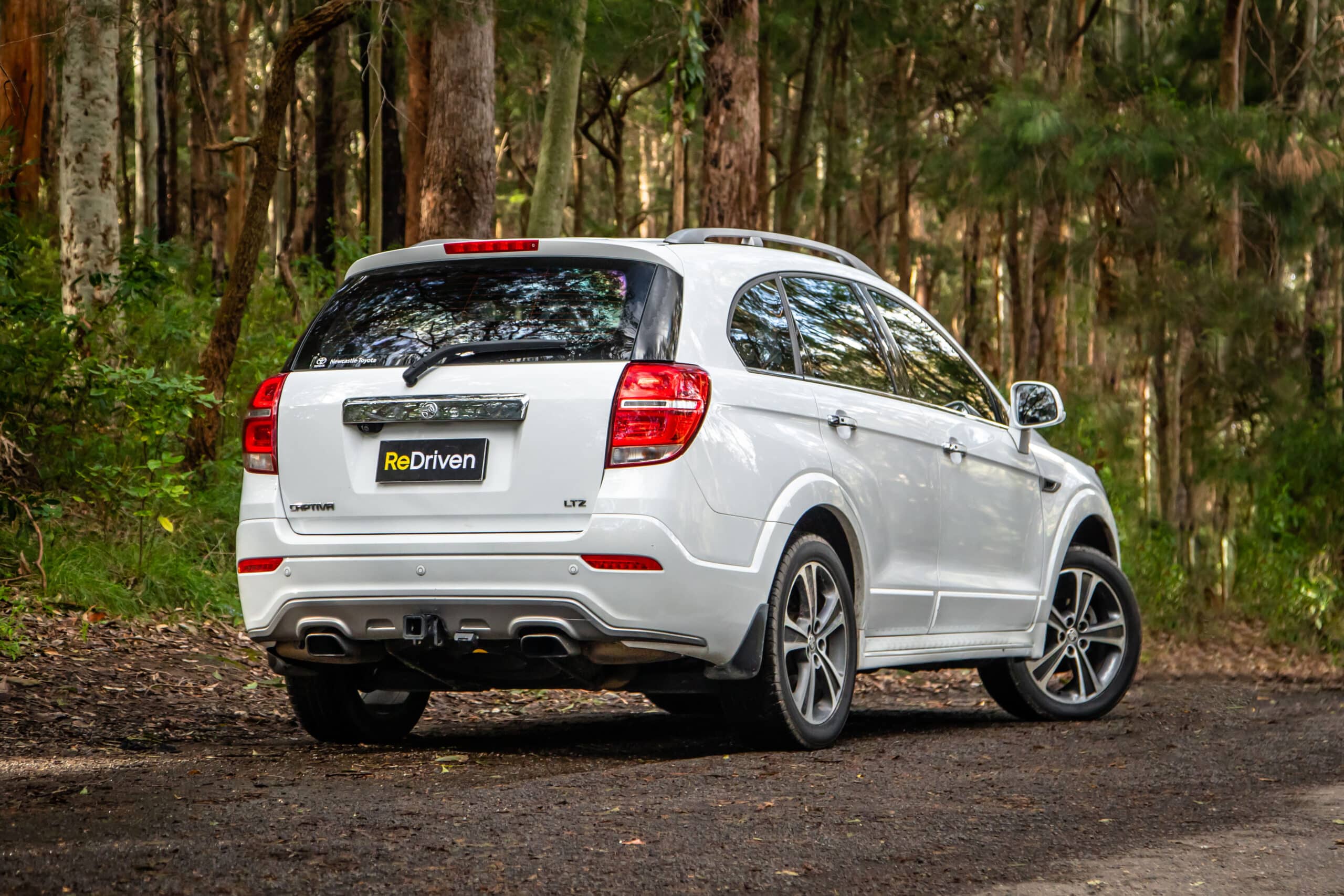Likes
- Quite inexpensive for an SUV in this class
- Good amount of equipment and features
- Good levels of practicality
- Ummm…













The Captiva mid-sized five- or seven-seater lobbed in the mid Noughties as Holden’s solution for a must-have large-ish SUV. It was GM/H response to Ford’s home-spun Territory and a replacement for the mixed-bag Commodore wagon-based Adventra and the imported Captiva couldn’t have more different in every way.
Its story is, erm, complicated. And can be a bit of a minefield for the casual used-tyre-kicker.
The Captiva was sourced from GM Korea, aka the former Daewoo. Well, both of them. See, the regular Captiva was a rebadged Chevrolet of the same model name, whereas the high-end Captiva MaXX version was instead based on an Opel Antara. Different vehicles, then, albeit with technical similarities in platform and with powertrains.
At its 2006 launch, there were three grades – SX, CX and LX – of regular Captiva, price between $36k and $42k. The Opel based (slightly shorter) MaXX range-topper was $43k. Despite the South Korean source, all version used an Aussie-made 169kW/297Nm 3.2 petrol V6 backed by a five-speed auto and on-demand all-wheel drive. To confuse matters (more), the SX and MaXX were five-seaters, the middle-rung variants offering seven…
For MY08, a 2.0-litre turbodiesel four outputting 110kW/320Nm lobbed and could had with a five- speed manual in base SX trim ($35k) as well as the staple automatic elsewhere in the range.
From mid-2008, you could also get the oiler SX in front-wheel drive. Right around here the Captiva story gets muddier. Holden axes the MaXX flagship, though it returns in spirit in late 2009 as the Captiva 5 (for five seats). And with the new name is fresh power by way of a new 103kW/220Nm 2.4-litre four-cylinder engine, with manual/auto and FWD/AWD options, kicking off as low as $28k.
From here, the ‘5’ sits along the renamed Captiva 7 (for…you get the idea) carrying over the petrol-V6 and diesel-four motivation as the higher-spec versions that nudge up to a $45k plateau. At least Holden kept the SX, CX and LX variant structure for familiar continuity.
Then the Series II facelift arrived in 2011 and the whole shebang copped another shake-up. The Captiva 5’s petrol 2.4 was upped to 123kW/230Nm as a front driver only (from $28k), but soon enough a more powerful 135kW/400Nm 2.2L diesel ‘5’ joined the fray ($34k) with a six-speed auto.
Meanwhile, the now (77mm) longer Series II Captiva 7 could be had with a new, Aussie-made, Commodore-shared 3.0-litre petrol V6 good for 190kW/288Nm. You could also get the new 2.2 oiler in the ‘7’, with both engines backed by a six-speed auto and AWD.
Just to ensure everyone was paying attention, Holden went and adopted (mid-spec) LT and (flagship) LTZ naming in 2015 – both seven seaters – while the familiar LS could be had with five or (optional) seven pews.
Digging down into features and options throughout Captiva’s dozen-year lifecycle is too exhaustive for here. But in a nutshell, Holden’s large-ish family hauler never really hit critical heights in its segment and was renown, fairly or not, for patchy quality and questionable reliability.
Holden would axed the Captiva 5 in 2016, the nameplate living on for a couple of years – as just Captiva, no ‘7’ – until the then seven-seat-only model was replaced by Equinox in 2018.
























You don’t have to buy a Captiva, and you should not buy a Captiva.
Yes on paper they offer a lot of equipment and features and when compared to their rivals, they seem to offer excellent value for money but the problem is, excluding maybe a couple of dozen unicorn examples out there, the Captiva is just a bad car.
Even the unicorn examples are average at best and there are just so many other better options, like public transport, walking or being shot out of a cannon.
Please do not buy a Captiva, they’re terrible and only getting worse.
You don’t have to buy a Captiva, and you should not buy a Captiva.
Yes on paper they offer a lot of equipment and features and when compared to their rivals, they seem to offer excellent value for money but the problem is, excluding maybe a couple of dozen unicorn examples out there, the Captiva is just a bad car.
Even the unicorn examples are average at best and there are just so many other better options, like public transport, walking or being shot out of a cannon.
Please do not buy a Captiva, they’re terrible and only getting worse.
You don’t have to buy a Captiva, and you should not buy a Captiva.
Yes on paper they offer a lot of equipment and features and when compared to their rivals, they seem to offer excellent value for money but the problem is, excluding maybe a couple of dozen unicorn examples out there, the Captiva is just a bad car.
Even the unicorn examples are average at best and there are just so many other better options, like public transport, walking or being shot out of a cannon.
Please do not buy a Captiva, they’re terrible and only getting worse.
Body style:
5-door SUV
Engines:
2.0 litre 4-cylinder petrol (Captiva 5) – Until 2011
2.0 litre 4-cylinder diesel (SX, CX, LX) – Until 2011
2.2 litre 4-cylinder diesel (SX, LS, Captiva 5, CX, LT, LX, LTZ) – From 2011
2.4 litre 4-cylinder petrol (SX, LS, Captiva 5, LT) – From 2011
3.2 litre V6 petrol (SX, CX, LX, Maxx) – Until 2011
3.0 litre V6 petrol (CX, LT, LX, LTZ) – From 2011
Power:
103kW – 2.0 litre 4-cylinder petrol
110kW – 2.0 litre 4-cylinder diesel
135kW – 2.2 litre 4-cylinder diesel
123kW – 2.4 litre 4-cylinder petrol
167kW – 3.2 litre V6 petrol (Maxx)
169kW – 3.2 litre V6 petrol (SX, CX, LX)
190kW – 3.0 litre V6 petrol
Torque:
220Nm – 2.0 litre 4-cylinder petrol
320Nm – 2.0 litre 4-cylinder diesel
400Nm – 2.2 litre 4-cylinder diesel
230Nm – 2.4 litre 4-cylinder petrol
297Nm – 3.2 litre V6 petrol
288Nm – 3.0 litre V6 petrol
Transmission & drive:
5-speed manual, front-wheel drive (FWD) – SX, Captiva 5
5-speed automatic, front-wheel drive (FWD) – SX
5-speed automatic, all-wheel drive (AWD) – SX, CX, LX, Maxx, Captiva 5
6-speed manual, front wheel-drive (FWD) – Captiva 5, LT – From 2011 to 2015
6-speed automatic, front wheel-drive (FWD) – Captiva 5, SX, LS, LT, LTZ – From 2011
6-speed automatic, all wheel-drive (AWD) – Captiva 5, SX, LS, CX, LT,
Body style:
5-door SUV
Engines:
2.0 litre 4-cylinder petrol (Captiva 5) – Until 2011
2.0 litre 4-cylinder diesel (SX, CX, LX) – Until 2011
2.2 litre 4-cylinder diesel (SX, LS, Captiva 5, CX, LT, LX, LTZ) – From 2011
2.4 litre 4-cylinder petrol (SX, LS, Captiva 5, LT) – From 2011
3.2 litre V6 petrol (SX, CX, LX, Maxx) – Until 2011
3.0 litre V6 petrol (CX, LT, LX, LTZ) – From 2011
Power:
103kW – 2.0 litre 4-cylinder petrol
110kW – 2.0 litre 4-cylinder diesel
135kW – 2.2 litre 4-cylinder diesel
123kW – 2.4 litre 4-cylinder petrol
167kW – 3.2 litre V6 petrol (Maxx)
169kW – 3.2 litre V6 petrol (SX, CX, LX)
190kW – 3.0 litre V6 petrol
Torque:
220Nm – 2.0 litre 4-cylinder petrol
320Nm – 2.0 litre 4-cylinder diesel
400Nm – 2.2 litre 4-cylinder diesel
230Nm – 2.4 litre 4-cylinder petrol
297Nm – 3.2 litre V6 petrol
288Nm – 3.0 litre V6 petrol
Transmission & drive:
5-speed manual, front-wheel drive (FWD) – SX, Captiva 5
5-speed automatic, front-wheel drive (FWD) – SX
5-speed automatic, all-wheel drive (AWD) – SX, CX, LX, Maxx, Captiva 5
6-speed manual, front wheel-drive (FWD) – Captiva 5, LT – From 2011 to 2015
6-speed automatic, front wheel-drive (FWD) – Captiva 5, SX, LS, LT, LTZ – From 2011
6-speed automatic, all wheel-drive (AWD) – Captiva 5, SX, LS, CX, LT, LX, LTZ – From 2011
Fuel consumption:
7.2 – 11.6L/100km
Dimensions:
Length:
4570 – 4637mm
Width:
1849 – 1850mm
Height:
1700 – 1720mm
Kerb weight:
1640 – 1810kg
Towing (unbraked/braked):
750kg / 2000kg (1700kg for Maxx and Captiva5 variants)
Body style:
5-door SUV
Engines:
2.0 litre 4-cylinder petrol (Captiva 5) – Until 2011
2.0 litre 4-cylinder diesel (SX, CX, LX) – Until 2011
2.2 litre 4-cylinder diesel (SX, LS, Captiva 5, CX, LT, LX, LTZ) – From 2011
2.4 litre 4-cylinder petrol (SX, LS, Captiva 5, LT) – From 2011
3.2 litre V6 petrol (SX, CX, LX, Maxx) – Until 2011
3.0 litre V6 petrol (CX, LT, LX, LTZ) – From 2011
Power:
103kW – 2.0 litre 4-cylinder petrol
110kW – 2.0 litre 4-cylinder diesel
135kW – 2.2 litre 4-cylinder diesel
123kW – 2.4 litre 4-cylinder petrol
167kW – 3.2 litre V6 petrol (Maxx)
169kW – 3.2 litre V6 petrol (SX, CX, LX)
190kW – 3.0 litre V6 petrol
Torque:
220Nm – 2.0 litre 4-cylinder petrol
320Nm – 2.0 litre 4-cylinder diesel
400Nm – 2.2 litre 4-cylinder diesel
230Nm – 2.4 litre 4-cylinder petrol
297Nm – 3.2 litre V6 petrol
288Nm – 3.0 litre V6 petrol
Transmission & drive:
5-speed manual, front-wheel drive (FWD) – SX, Captiva 5
5-speed automatic, front-wheel drive (FWD) – SX
5-speed automatic, all-wheel drive (AWD) – SX, CX, LX, Maxx, Captiva 5
6-speed manual, front wheel-drive (FWD) – Captiva 5, LT – From 2011 to 2015
6-speed automatic, front wheel-drive (FWD) – Captiva 5, SX, LS, LT, LTZ – From 2011
6-speed automatic, all wheel-drive (AWD) – Captiva 5, SX, LS, CX, LT, LX, LTZ – From 2011
Fuel consumption:
7.2 – 11.6L/100km
Dimensions:
Length:
4570 – 4637mm
Width:
1849 – 1850mm
Height:
1700 – 1720mm
Kerb weight:
1640 – 1810kg
Towing (unbraked/braked):
750kg / 2000kg (1700kg for Maxx and Captiva5 variants)
Warranty:
3 years/100,000kms
5 years/unlimited kms (from 1st July 2018)
Servicing:
9 months/15,000kms (Maxx, Captiva 5 models)
12 months/15,000kms (All other models, Captiva 7 models)
Have ultimate peace of mind when buying a used car by purchasing an official PPSR report.
Please note that pricing information is subject to fluctuations in the automotive market.
Information correct as of July 29, 2022.
The advice provided on this website is general advice only. It has been prepared without taking into account your objectives, financial situation or needs. Before acting on this advice, you should consider the appropriateness of the advice, having regard to your own objectives, financial situation and needs.
Read our full terms and conditions here.
© 2024 ReDriven All Rights Reserved